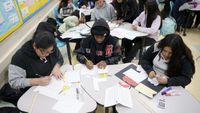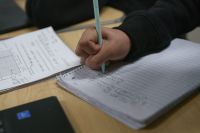Explore web search results related to this domain and discover relevant information.

A decade-long slide in high school students’ performance in reading and math persisted during the COVID-19 pandemic, with 12th graders’ scores dropping to their lowest level in more than 20 years.
WASHINGTON (AP) — A decade-long slide in high schoolers’ reading and math performance persisted during the COVID-19 pandemic, with 12th graders’ scores dropping to their lowest level in more than 20 years, according to results released Tuesday from an exam known as the nation’s report card.The assessments were the first since the pandemic for eighth graders in science and 12th graders in reading and math. They reflect a downward drift across grade levels and subject areas in previous releases from NAEP, which is considered one of the best gauges of the academic progress of U.S.In math, the average score in 2024 was the lowest since 2005, when the assessment framework changed significantly. On the test, 45% of high school seniors scored below “basic” achievement, the highest percentage since 2005.The gap between the highest- and lowest-performing students was its widest ever among eighth grade science students, reflecting growing inequality in the American school system. The achievement gap widened also in 12th grade math.
Original story reprinted with ... understanding of science by covering research developments and trends in mathematics and the physical and life sciences. In your inbox: The week’s biggest tech news in perspective...
Original story reprinted with permission from Quanta Magazine, an editorially independent publication of the Simons Foundation whose mission is to enhance public understanding of science by covering research developments and trends in mathematics and the physical and life sciences. In your inbox: The week’s biggest tech news in perspectiveIn theory, quantum physics can bypass the hard mathematical problems at the root of modern encryption. A new proof shows how.In between, securing those day-to-day applications to mathematical bedrock, is a foundation made of building blocks called one-way functions. They’re responsible for the asymmetry inherent in any encryption scheme.The crucial difference lay in the nature of the locks. Classical one-way functions generate mathematical locks made of bits—the 0s and 1s that store information in a classical computer. Quantum one-way state generators would instead generate locks made of units of quantum information called qubits.

According to the first-ever survey fielded by RAND's new American Youth Panel (AYP), 49% of students in middle and high school grades reported losing interest in math about half or more of the time, and 75% of youths reported ...
The strength of certain neural connections can predict how well someone can learn math, and mildly electrically stimulating these networks can boost learning, according to a study published in the open-access journal PLOS ...According to the first-ever survey fielded by RAND's new American Youth Panel (AYP), 49% of students in middle and high school grades reported losing interest in math about half or more of the time, and 75% of youths reported ...Humans beat generative AI models made by Google and OpenAI at a top international mathematics competition, despite the programs reaching gold-level scores for the first time.A London-based dentist may have cracked a centuries-old mathematics puzzle hidden in one of the most famous anatomical drawings in the world—Leonardo da Vinci's Vitruvian Man.


Efforts to close the gender gap in STEM education are gaining momentum after setbacks during the COVID-19 pandemic.
In de Zavala’s first year as a choice school focused on science, technology, engineering and math, the school recruited a sixth grade class that’s half girls. School leaders are hoping the girls will stick with STEM fields.In the years leading up to the pandemic, the gender gap nearly closed. But within a few years, girls lost all the ground they had gained in math test scores over the previous decade, according to an Associated Press analysis.In most school districts in the 2008-2009 school year, boys had higher average math scores on standardized tests than girls, according to AP’s analysis, which looked at scores across 15 years in over 5,000 school districts.A separate study by NWEA, an education research company, found gaps between boys and girls in science and math on national assessments went from being practically non-existent in 2019 to favoring boys around 2022.
The quest to find the longest-running simple computer program has identified a new champion. It’s physically impossible to write out the numbers involved using standard mathematical notation.
Amid the chaos of revolutionary France, one man’s mathematical obsession gave way to a calculation that now underpins much of mathematics and physics.The proof, known to be so hard that a mathematician once offered 10 martinis to whoever could figure it out, connects quantum mechanics to infinitely intricate mathematical structures.The quest to find the longest-running simple computer program has identified a new champion. It’s physically impossible to write out the numbers involved using standard mathematical notation.Illuminating basic science and math research through public service journalism.


It's the first Nation's Report Card since the Trump administration began making cuts to the U.S. Education Department. The scores reflect the state of student achievement in early 2024.
New test scores from the National Assessment of Educational Progress (NAEP), also known as the Nation's Report Card, show eighth-graders' science scores have fallen 4 points since 2019 and 12th-graders' math and reading scores have fallen 3 points in the same time period.Nation’s Report Card: Science, math and reading scores are down It's the first Nation's Report Card since the Trump administration began making cuts to the U.S. Education Department.Today, the assessments in math and reading are given every two years to a broad sample of students in fourth and eighth grades; 12th-graders receive them every four years.Twelfth-grade math scores dropped the same amount as reading scores and were 3 points lower than in 2005, the first time this version of the math test was administered.

In Oakland’s public schools, girls and boys had similar math scores in 2019. Five years later, boys’ scores had risen and girls had dropped by 19%.
Girls closed the gender gap in math; then the pandemic struckJust before the pandemic struck, girls had overtaken boys’ scores in math and finally closed the long-standing gender gap in a subject that is a gateway to the fields of science, technology, engineering and math.The Associated Press analyzed data from the Stanford Education Data Archive and found that in the decade before the pandemic, girls had not only improved math scores nationwide, but they were also outscoring boys.National experts in math have not definitively pinpointed which factors have contributed to this widening gap, but school closures at the height of the pandemic do not seem to explain it, according to Megan Kuhfeld, director of growth modeling and data analytics for the education research company NWEA.The trend persists in Oakland Unified School District, where girls’ math scores dropped nearly 19% between 2019 and 2024. In 2019, girls in OUSD were scoring about two grades below the national average. By 2024, girls were down by about 2.5, on average. Boys’ scores rose by about 4%, but still remain two grades lower than average.

Gender disparities in math proficiency emerge only after children start school, according to a new study coauthored by Harvard Professor of Psychology Elizabeth S. Spelke ’71 and published in the science journal Nature in June.
Harvard Study Finds Gender Gap in Math Achievement Starts in Early Schooling | News | The Harvard CrimsonEven though the factors driving the observed gender gap remain unclear, Spelke said further research into its causes would enable schools to redesign their math curriculums in order to better support all students.Gender disparities in math proficiency emerge only after children start school, according to a June study coauthored by Harvard Professor of Psychology Elizabeth S.Spelke and an international research team analyzed four years worth of data on more than 2.5 million French students to pinpoint when the long-documented gender gap in math achievement begins.
The report shows almost half of high school seniors are now testing below basic levels in math and reading, and approximately 35% are at or above a proficient reading level, while 32% of them had a below "basic" reading proficiency.
High school students, especially 12th graders, are reading and learning math and science at historic lows, according to a new report from the National Assessment of Education Progress.The report shows almost half of high school seniors are now testing below basic levels in math and reading, and approximately 35% are at or above a proficient reading level, while 32% of them had a below "basic" reading proficiency.In math, the report shows only about 22% of 12th graders performing at or above proficiency standards.Marty West, a professor of education at Harvard University, told ABC News the results are concerning because only a portion of American students are getting the education they deserve.


Two Comal ISD students were recently accepted into a prestigious educational program.
Trevor Guerrero of Oak Creek Elementary and Liam Quade of Mountain Valley Elementary were each nominated by their respective schools for National Math Stars. After extensive testing and interviews over the summer, each third grader received his acceptance letter.National Math Stars is a 10-year, fully funded program that supports each student’s love of mathematics from as early as third grade through the end of high school. Support comes in the form of additional math classes, educational tools and summer camps.National Math Stars selects only 100 students nationwide to participate in the program.Over the ten-year program, National Math Stars invests more than $100,000 in support and resources for each student in the fields of mathematics, science and technology.
Get the latest in math news and mathematics industry advancements from the editors of Popular Mechanics.
In math, the average score in 2024 was the lowest since 2005, when the assessment framework changed significantly. On the test, 45% of high school seniors scored below “basic” achievement, the highest percentage since 2005.
AP News Code of Conduct · Sign in · Show Search Menu · Education · 1 of 2 | · A decade-long slide in high schoolers’ reading and math performance persisted during the COVID-19 pandemic, with 12th graders’ scores dropping to their lowest level in more than 20 years, according to results released Tuesday from an exam known as the nation’s report card.WASHINGTON (AP) — A decade-long slide in high schoolers’ reading and math performance persisted during the COVID-19 pandemic, with 12th graders’ scores dropping to their lowest level in more than 20 years, according to results released Tuesday from an exam known as the nation’s report card.The assessments were the first since the pandemic for eighth graders in science and 12th graders in reading and math. They reflect a downward drift across grade levels and subject areas in previous releases from NAEP, which is considered one of the best gauges of the academic progress of U.S.In math, the average score in 2024 was the lowest since 2005, when the assessment framework changed significantly. On the test, 45% of high school seniors scored below “basic” achievement, the highest percentage since 2005.


U.S. 12th graders’ reading and math scores fell to their lowest levels on record in 2024, according to the test dubbed “the nation’s report card.”
Average reading and math scores among 12th graders fell to their lowest levels on record in 2024, according to the latest results from the National Assessment of Educational Progress (NAEP), often referred to as “the nation’s report card.” Meanwhile, eighth graders’ scores on a science test slipped as well.The average math score for 12th graders – 147 on a 300-point scale – was the lowest since the assessment began in 2005. Only 22% of 12th graders solved math problems at a level deemed at or above proficiency in 2024.The downward trajectory of science scores could reflect a post-pandemic emphasis on reading and math that cut into time for other content areas, says Christine Cunningham, senior vice president for STEM Learning at the Museum of Science in Boston and a member of the National Assessment Governing Board.Students do best, Dr. Cunningham says, when they have an interest in the topic and can find relevance within their own lives or the world around them. That could lead to integration with math and reading.

That’s because a series can continue to build out values well into the tiniest digits. If a mathematician compiles a series’ terms, they can use the resulting abstraction to do math that isn’t possible with an approximation of pi that’s cut off at 10 digits by a standard desk calculator.
All of that requires decades of foundational work in the field and large bodies of work showing that certain mathematical moves work where other ones don’t. It’s a comment on the ongoing and collaborative nature of math theory, even when what results is a working model that might help scientists.Caroline Delbert is a writer, avid reader, and contributing editor at Pop Mech. She's also an enthusiast of just about everything. Her favorite topics include nuclear energy, cosmology, math of everyday things, and the philosophy of it all.As detailed in their paper, Saha and Sinha combined two existing ideas from math and science: the Feynman diagram of particle scattering and the Euler beta function for scattering in string theory.What results is a series—something represented in math by the Greek letter Σ surrounded by parameters.

(NEXSTAR) — School is back in session, bringing in the first wave of students born during the pandemic, dubbed “COVID kindergartners,” into classrooms nationwide. The students older than them, however, still seem to be trying to rebound from their pandemic-era learning disruptions.
Across the four regions of the country considered in the report — Northeast, Midwest, South, and West — only the West did not see a significant difference in eighth-grade science scores between 2019 and 2024. In the other three, scores declined. Twelfth-grade math scores declined for students in the South and West, while reading scores among the same age group dropped in the Midwest and South.Earlier this year, the NCES released data analyzing fourth- and eighth-grade math and reading scores. The report showed small gains in math for the younger students but no improvement for the older group. Reading scores dropped for both age levels.Meanwhile, the gap between the highest- and lowest-performing students was its widest ever among eighth-grade science students, reflecting growing inequality in the American school system. The achievement gap also widened in twelfth-grade math.The latest report from the National Assessment of Educational Progress (NAEP), shows that eighth- and twelfth-graders are still struggling in key subjects. According to the Nation’s Report Card, the average score across three categories in particular declined in 2024 compared to 2019: eighth-grade science and twelfth-grade math and reading.

High school students, especially 12th graders, are reading and learning math and science at historic lows, according to a new report.
High school students, especially 12th graders, are reading and learning math and science at historic lows, according to a new report from the National Assessment of Education Progress.The report shows almost half of high school seniors are now testing below basic levels in math and reading, and approximately 35% are at or above a proficient reading level, while 32% of them had a below "basic" reading proficiency.In math, the report shows only about 22% of 12th graders performing at or above proficiency standards."Today's NAEP results confirm a devastating trend: American students are testing at historic lows across all of K-12," McMahon said, adding, "Despite spending billions annually on numerous K-12 programs, the achievement gap is widening, and more high school seniors are performing below the basic benchmark in math and reading than ever before."
The MAA provides faculty members with comprehensive resources that enhance teaching, research, and professional development. We support your professional growth while enabling you to contribute to the broader mathematical community.
The MAA supports students from K-12 to higher education. K-12 students can enjoy fun math challenges, AMC competitions, and interactive materials to explore math and STEM careers. Higher education students have access to resources to enhance their skills, research, and job prospects.The MAA supports STEM and mathematical sciences professionals. Enhance your skills, stay updated with research, and advance your career. Access to the MAA Career Center, connect with our industry-specific special interest groups, and engage with cutting-edge research.Charles Wilkes, an MAA Project NExT alumnus, brings a deep commitment to equity, mentorship, and meaningful connection in mathematics. In this spotlight, he reflects on the value of community, offers advice for new MAA MathFest attendees, and shares how MAA Project NExT shaped his path as a mathematics educator.Washington, DC - The United States team, sponsored by the Mathematical Association of America (MAA), has secured second place in the 66th International Mathematical Olympiad (IMO), held from July 10 to July 20, 2025, on the Sunshine Coast of Australia.
Explore a wide range of recent research in mathematics. From mathematical modeling to why some people have difficulty learning math, read all the math-related news here.
May 30, 2025 A new study integrated mathematical modeling with advanced imaging to discover that the physical shape of the fruit fly egg chamber, combined with chemical signals, significantly influences how cells ...May 29, 2025 Scientists have developed a unified theory for mathematical parameters known as gauge freedoms. Their new formulas will allow researchers to interpret research results much faster and with greater confidence.Feb. 26, 2025 Physicists bring unprecedented levels of predictability to the ancient practice of knitting by developing a mathematical model that could be used to create a new class of lightweight, ultra-strong ...Feb. 13, 2025 Is it possible to tile a surface with a single shape in such a way that the pattern never repeats itself? In 2022, a mathematical solution to this 'Einstein problem' was discovered for the ...

Strogatz has been busy with outreach activities as the inaugural Susan and Barton Winokur Distinguished Professor for the Public Understanding of Science and Mathematics.
Sylvan Martin is majoring in mathematics and computer science.Songyu Ye is majoring in mathematics and computer science.Elizaveta Zabelina is a Robert S. Harrison College Scholar who is also majoring in mathematics and psychology.Sara Yoo is majoring in economics & mathematics.
Displaying 1 - 15 of 640 news articles related to this topic.
MIT News · Topics · Mathematics · Download RSS feed: News Articles / In the Media / Audio · Displaying 1 - 15 of 640 news articles related to this topic. The CodeSteer system could boost large language models’ accuracy when solving complex problems, such as scheduling shipments in a supply chain.



